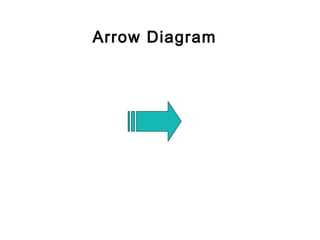
Arrow diagram
- 2. Activity Network diagram, CPM, CPS, PERT Description The arrow diagram is used to plan and show the required order of tasks in a project or process, the best schedule for the entire project, and potential scheduling and resource problems and their solutions. The arrow diagram, lets you calculate the critical path of the project. This is the flow of critical steps where delays will affect the timing of the entire project, and where addition of resources can speed up the project.
- 3. When to use • When planning a complex project or process with interrelated tasks and resources. • When analyzing the timing of a project; this analysis can happen before, during or after the project. • When allocating resources (such as people, money and time) to a project. • When monitoring the progress of a project. • When replanning a project in progress, due to changes in conditions or resources. • Only when you know the steps of the project or process, their sequence, and how long each steps takes.
- 4. Procedure Planning 1. List all the necessary tasks in the project or process. One convenient method is to write each task on the top half of a card or Post It note. Across the middle of the card, draw a horizontal arrow pointing right. 2. Determine the correct sequence of the tasks. Do this by asking three questions for each task. • Which tasks must happen before this one can begin? • Which tasks can be done at the same time as this one? • Which tasks should happen immediately after this one? It can be useful to create a table with four columns - prior tasks, this task, simultaneous tasks, following tasks.
- 5. Procedure... 3. Diagram the network of tasks. If you are using notes or cards, arrange them in sequence on a large piece of paper. Time should flow from left to right and concurrent tasks should be vertically aligned. Leave space between the cards. 4. Between each two tasks, draw circles for events. An event marks the beginning or end of a task, a milestone for the project. Thus, events are nodes that separate tasks.
- 6. Procedure... 5. Look for three common problem situations and redraw them using dummies or extra events. A dummy is an arrow drawn with dotted line to separate tasks that would otherwise start and stop with the same events, or to show logical sequence of tasks. Dummies are not real tasks. 6. When the network is correct, label all events in sequence with event numbers in the circle. It can be useful to label all tasks in sequence, using letters.
- 7. Scheduling 7. Determine the take times. The task time is the best estimate of the time that each task should require. Use one consistent measuring unit (hours, days, weeks). Write the time on each task’s arrow. 8. Determine the critical path. The critical path is the longest path from the beginning to the end of the project. Mark the critical path with a heavy line or color. Calculate the length of the critical path: the sum of all the task times on the path.
- 8. Scheduling... 9. Calculate the earliest times each task can start and finish, based on how long preceding tasks take. Start with the first task, where the earliest start is zero, and work forward. Earliest start (ES) = the largest earliest finish of the tasks leading into this one. Earliest finish (EF) = earliest start + task time
- 9. Scheduling... 10. Calculate the latest times each task can start and finish without upsetting the project schedule, based on how long later tasks will take. Start from the last task, where the latest finish is the project deadline and work backwards. Latest finish (LF) = the smallest latest start of all the tasks leading out this one. Latest start (LS) = latest finish - task time
- 10. Scheduling... 11. Write all four times - ES. EF, LS, LF - beside the task arrow. One common way to show them is in four boxes arranged as follows:( Example of the arrow diagram on the next two slides ) Earliest Earliest start finish Latest Latest start finish
- 11. Earliest start Earliest finish Number of days 1 0 5 Latest finish 5 Develop broad plan 3 8 Latest start 2 5 7 2 Get approval 8 10 3 7 17 10 Identify team 10 20 4 17 19 2 Train team 20 22 19 21 Develop detailed plan 24 26 5 2 19 23 6 4 Conduct research 22 26 0 7 23 26 3 Identify key practices 28 31
- 12. 8 23 38 Identify partners 27 42 15 23 33 10 Collect data 26 36 Critical path 2 0 Identify current Develop 11 state questions 26 28 26 37 10 40 42 31 42 9 Critical path 0 6 33 39 Analyze data 39 45 36 42 Visit partners 6 11 48 54 39 51 12 Develop new process 12 42 54 0 13 2 51 53 Finalize new process Critical path 54 56 14 53 57 4 Get approval for implementation 56 60 15
